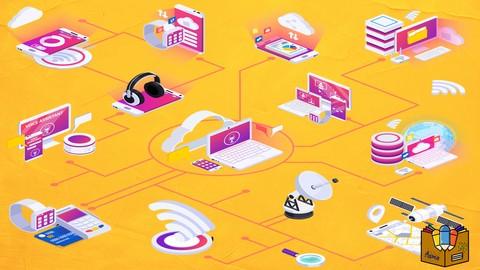Last Updated on December 25, 2024 by GeeksGod
Course : How to Develop REST Web API using ASP.NET MVC
“`htmlMastering ASP.NET MVC REST API: Your Ultimate Guide
Are you ready to dive into the world of Web APIs? If you’re building applications that require data exchange between a client and a server, understanding the ASP.NET MVC REST API is crucial. This article will guide you through essential concepts, practical skills, and even a Free Udemy Coupon to kickstart your learning journey.
What is REST Web API?
REST stands for Representational State Transfer. It is an architectural style that defines a set of constraints and properties based on HTTP. In simple terms, REST is a way for applications to communicate over the web, allowing systems to exchange data. For instance, when you shop online, the application communicates with the server via a REST API to retrieve product information.
Why Use ASP.NET MVC for REST APIs?
ASP.NET MVC is a powerful framework for building dynamic web applications. It provides a clean separation of concerns and is designed for easy integration with various data sources. Utilizing ASP.NET MVC for your REST API comes with the following benefits:
- Rich support for routing and URL management
- Strong security features for protecting your data
- Extensive libraries and dependencies
- Easy integration with the Entity Framework for database interactions
Setting Up Your First ASP.NET MVC REST API Project
Let’s get started! Setting up a basic REST API project using ASP.NET MVC is straightforward. Follow these steps:
- Open Visual Studio and create a new ASP.NET Web Application.
- Choose the MVC template for your project.
- Add the required packages for Web API using NuGet Package Manager.
- Define your routes in the WebApiConfig file.
- Start writing your controllers that will handle the API requests.
With these steps done, you now have the skeleton of your ASP.NET MVC REST API!
Security in ASP.NET MVC REST API
Security is paramount when developing any API. Here, we’ll look at how to generate REST Web API Security Keys and implement authentication.
Generating Security Keys
A security key serves as a safeguard against unauthorized API access. To generate a security key:
- Identify your user authentication requirements.
- Use libraries like IdentityServer to manage token generation.
- Implement OAuth for token-based authentication.
For a deeper dive into security, check out resources like the official documentation on ASP.NET Core Security.
Understanding JSON Objects in C#.NET
JSON (JavaScript Object Notation) is a lightweight data interchange format. In C#, JSON objects can easily be mapped using libraries like Newtonsoft.Json. This mapping is essential for data serialization and deserialization when exchanging information between the client and server.
Creating REST API Methods
Let’s look at how to handle HTTP requests in your ASP.NET MVC REST API.
HTTP GET Method
Creating an HTTP GET method is necessary for fetching data. For example:
“`csharp
[HttpGet]
public IEnumerable
{
return db.Products.ToList();
}
“`
This GET request will return a list of products from your database. Want to filter products? Here’s how you can set up a method with query parameters:
“`csharp
[HttpGet]
public IEnumerable
{
return db.Products.Where(p => p.Category == category).ToList();
}
“`
HTTP POST Method
To create new records, you’ll use the HTTP POST method:
“`csharp
[HttpPost]
public IHttpActionResult PostProduct(Product product)
{
if (!ModelState.IsValid)
{
return BadRequest(ModelState);
}
db.Products.Add(product);
db.SaveChanges();
return CreatedAtRoute(“DefaultApi”, new { id = product.Id }, product);
}
“`
Handling Routing in ASP.NET MVC REST API
ASP.NET MVC allows for flexible routing options. You might want to change the method names or implement custom routing. Here’s how to implement name routing:
config.Routes.MapHttpRoute(
name: "MyApi",
routeTemplate: "api/{controller}/{action}/{id}",
defaults: new { id = RouteParameter.Optional }
);
This flexibility ensures that your API endpoints are user-friendly and intuitive.
Managing Database Connections with Entity Framework
Entity Framework (EF) simplifies database interactions in .NET applications. To connect your REST API to SQL Server using EF’s Database First approach:
- Generate a database from existing tables using EF tools.
- Create a model class that maps to your database entities.
- Use the DbContext class to query your database effortlessly.
For more on EF, refer to the official Entity Framework documentation.
Advanced Topics in ASP.NET MVC REST API Development
Once you have mastered the basics, it’s time to delve into advanced topics that can enhance your ASP.NET MVC REST API:
- Implementing versioning for your API to manage changes
- Using middleware for custom error handling
- Creating OAuth2 authentication for third-party integrations
Start Your Learning Journey with a Free Udemy Coupon
Ready to take your skills to the next level? There’s a fantastic opportunity for you to explore more in-depth content about the ASP.NET MVC REST API. Grab your Free Udemy Coupon today and access a course that covers everything you need.
FAQs about ASP.NET MVC REST API
What is the difference between REST and SOAP?
REST is more lightweight and uses standard HTTP protocols, while SOAP is a protocol that defines a set of rules for structuring messages.
What tools do I need to build an ASP.NET MVC REST API?
You’ll need Visual Studio and the .NET SDK, along with any necessary NuGet packages for specific functionalities.
Is ASP.NET MVC still relevant for API development?
Yes, ASP.NET MVC remains a popular choice due to its robust framework and extensive community support.
How do I test my API?
Use tools like Postman or Swagger for testing your APIs effectively and comprehensively.
Conclusion
In conclusion, mastering the ASP.NET MVC REST API opens doors to creating robust web services and applications. With an understanding of fundamental concepts, the ability to manage security, and database interactions utilizing the Entity Framework, you are well-equipped to tackle API development challenges. Don’t forget to take advantage of the Free Udemy Coupon to enhance your learning further. Happy coding!
“`














